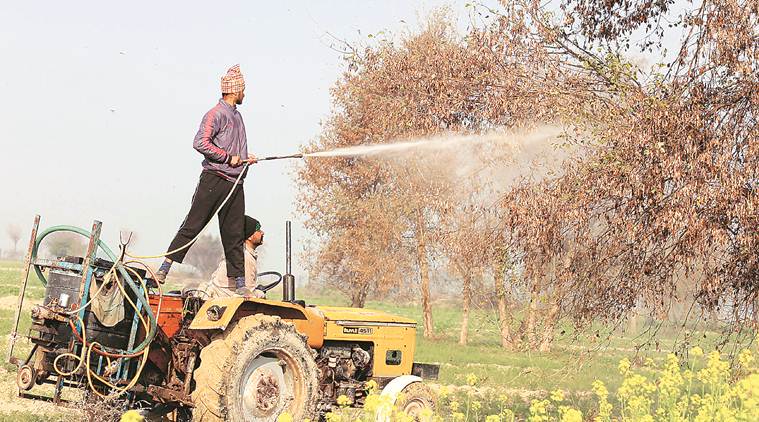 Farmers spray pesticides to control locusts in Sri Ganganagar. (Archive)
Farmers spray pesticides to control locusts in Sri Ganganagar. (Archive)
Ahead of monsoon rains in Rajasthan, the Food and Agriculture Organisation (FAO) of the United Nations has said that desert locusts, which have proceeded east, are expected to return to the state to mature and lay eggs while successive waves of swarms will arrive from southern Iran and the Horn of Africa in the coming weeks.
The desert locusts normally live and breed in semi-arid/desert region, hence the suitability of Rajasthan. As for swarms from Horn of Africa, the FAO says those from northern Somalia can migrate to breeding areas along both sides of India-Pakistan border.
Last month, spring-bred swarms migrated from southwest Pakistan to Rajasthan and some swarms continued to northern states of the country for the first time since 1962. These swarms are oscillating east and westwards and “these infestations are expected to return to Rajasthan with the onset of the rains to rapidly mature and lay eggs,” the FAO has said in a June 20 update.
However, Rajasthan Agriculture Commissioner Om Prakash said that the preparations this time around are ‘more robust’ than last year. For the renewed threat around monsoon, Prakash said, “We have had this information since long as we are in touch with them (FAO) and the preparation is more than what we had last year.”
The Commissioner said that between May 2019 and February 15, 2020, over 6 lakh hectares were affected in the state while this year, the figure stands at about 2 lakh hectare.
Of these 2 lakh hectares, as per Bansidhar Jat, Additional Director (Plant Protection), locusts have been controlled in 1,84,252 hectares as of Tuesday – 97,341 hectares by the Locust Warning Organisation and remainder by the state’s Agriculture Department.
The first swarms had entered the border districts of Jaisalmer and Sri Ganganagar on April 11. In May, the swarms entered 25 other districts including Jodhpur, Jaipur etc. and in June they entered three more districts. Currently, they have been spotted in 30 out of state’s 33 districts.
The Agriculture Department has approved 120 vehicles for locust survey while another 45 vehicles have been approved for locust control, apart from 800 tractor-mounted sprayers as well as 3,200 water tankers with tractors. As per agriculture department, the tractor mounted sprayers numbered 450 last year “and we have also asked the District Collectors to use more as per local requirement,” Prakash said.
Additionally, the Commissioner said that while there were fewer survey teams last year, there are over 200 survey teams now, while ‘40-50’ fire brigades are being used on a regular basis. Moreover, the subsidy on pesticides to control locusts has been increased from 50 per cent last year to 100 per cent this year. On May 27, the Ministry of Civil Aviation had also permitted the state government to use drones for anti-locust operations.